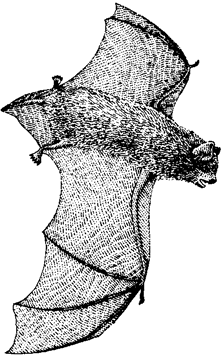
Silver-haired Bat
Distribution, Abundance, and Seasonality
Summer distribution of the silver-haired bat includes coastal and montane forests from the Oregon border south along the coast to San Francisco Bay, and along the Sierra Nevada and Great Basin region to Inyo Co. This species also is recorded in Stanislaus and Monterey cos. During spring and fall migrations and in winter, the silver-haired bat may be found anywhere in California. There may be some sexual segregation in the summer range, females occurring further to the north. Silver-haired bats are common, but erratic in abundance. Summer habitats include coastal and montane coniferous forests, valley foothill woodlands, pinyon- juniper woodlands, and valley foothill and montane riparian habitats. Summer range is generally below 2750 m (9000 ft) (Barbour and Davis 1969, Izor 1979, Kunz 1982).

Range Map
Specific Habitat Requirements
Feeding: Feeds mainly on moths and other soft-bodied insects. Also eats beetles and hard-shelled insects to some extent. Foraging flight is slow and fluttery with short glides. Feeds less than 6 m (20 ft) above forest streams, ponds, and open brushy areas. Uses echolocation to locate prey.
Cover: Roosts in hollow trees, snags, buildings, rock crevices, caves, and under bark.
Reproduction: Females may form nursery colonies or occur as solitary individuals in dense foliage or hollow trees.
Water: Needs drinking water. Poor urine-concentrating ability probably restricts this species to mesic habitats (Geluso 1978).
Pattern: Primarily a forest dweller, feeding over streams, ponds, and open brushy areas.
Species Life History
Activity Patterns: Hibernates. Most activity is crepuscular. Emerges earlier than most bats.
Seasonal Movements / Migration: Migrates to hibernation site. May make long migratory flights. Though the migratory paths of individual bats are unknown, it is likely that some California silver-haired bats winter in Mexico. Migration often results in occurrences in habitats or locations out of the normal range.
Home Range: One study measured a circular foraging range of 46-91 m (150-300 ft) diameter. Abundance is erratic.
Territory: None reported.
Reproduction: Mates in autumn, beginning in late August. Sperm is stored over the winter. After a gestation of 50-60 days, the young are born from May-July. 0ne or two young (average 1.8) are born. Lactation lasts about 36 days. The young are mature in their first summer. This species has been shown to live to 12 yr.
Niche: Where occurs with red and hoary bats, the species differ in time of activity (Kunz 1973). Where the big brown bat is numerically superior, the silver-haired bat shifts to a later activity time (Whitaker et al. 1977). May be found foraging with a wide variety of bat species. This species has been classified as a "moth strategist" (Black 1974), but diet varies with study location. Rabies is known to occur in silver-haired bats. Owls and skunks have been known to prey on this bat.
Sources & References
California Department of Fish and Game, 1999.
California's Wildlife, Sacramento, CA.
Written by: J. Harris, reviewed by: P. Brown, edited by: D. Alley, R. Duke
Barbour, R. W., and W. H. Davis. 1969. Bats of America. Univ. of Kentucky Press, Lexington. 286pp. Black, H. L. 1974. A north temperate bat community: structure and prey populations. J. Mammal. 55:138-157. Bond, S. I. 1977. An annotated list of the mammals of San Diego Co., California. Trans San Diego Soc. Nat. Hist. 18:229-248. Brown, P. E. 1980. Distribution of bats of the California Channel Islands. Pages 751-756 in D. M. Power, ed. The California Islands. Santa Barbara Mus. Nat. History. 787pp. Frum, W. G. 1953. Silver-haired bat, Lasionycteris noctivagans, in West Virginia. J. Mammal. 499-500. Geluso, K. N. 1978. Urine concentrating ability and renal structure of insectivorous bats. J. Mammal. 59:312-323. Izor, R. J. 1979. Winter range of the silver-haired bat. J. Mammal 60:641-643. Krutzsch, P. H. 1966. Remarks on silver-haired and Leib's bats in eastern United States. J. Mammal. 47:121. Kunz, T. H. 1973. Population studies of the cave bat (Myotis velifer): reproduction, growth and development. Occas. Pap. Univ. Kans. Mus. Nat. Hist. 15:1-43. Kunz, T. H. 1974. Feeding ecology of a temperature insectivorous bat (Myotis velifer). Ecology 55:693-711. Kunz, T. H. 1982. Lasionycteris noctivagans. Mammal. Species No. 172. 5pp. Reith, C. C. 1980. Shifts in time of activity by Lasionycteris noctivagans. J. Mammal. 61:104-108. Schwartz, C. W., and E. R. Schwartz. 1959. The wild mammals of Missouri. Univ. Missouri Press and Missouri Conserv. Comm., Columbia. 339pp. Whitaker, J. O., Jr., C. Maser, and L. E. Keller. 1977. Food habits of bats of western Oregon. Northwest Sci. 51:46-55. Williams, D. F., and J. S. Findley. 1979. Sexual and size dimorphism in vespertilionid bats. Am. Midl. Nat. 102:113-126.
California Animal Facts | California's Wildlife